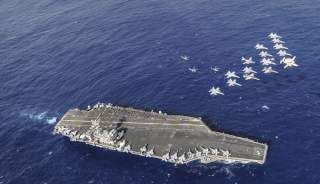How the U.S. Navy Plans to Keep the Aircraft Carrier from Becoming Obsolete
And it involves some new technology.
What would it mean to aircraft carrier power projection and attack capability if its fighters could double the range at which they hold enemy targets at risk? Could such a prospect substantially extend the envelope of offensive attack operations, while allowing carriers themselves to operate at safer distances?
Perhaps enemy targets 1,000 miles away, at sea or deep inland, could successfully be destroyed by carrier-launched fighters operating with a vastly expanded combat radius. Wouldn't this be of crucial importance in a world of quickly evolving high-tech missile and aircraft threats from potential adversaries such as near-peer rivals? Perhaps of equal or greater relevance, what if the re-fueler were a drone, able to operate in forward high-risk locations to support fighter jets - all while not placing a large manned tanker aircraft within range of enemy fire?
How America Could Go to War with Iran
While some of these questions may, upon initial examination, seem rhetorical or rather obvious -- they are at the heart of a now very critical Navy effort to engineer a new carrier-launched re-fueler by the early to mid 2020s. The drone aircraft, it appears, could bring the promise of more than doubling the strike range of an F/A-18 or F-35C.
Why North Korea's Air Force is Total Junk
With this end in mind, the Navy has recently released a draft Request For Proposal asking industry for design ideas, technologies and a full range of potential offerings or solutions which might meet the aforementioned criteria.
Why Doesn't America Kill Kim Jong Un?
The concept of the effort, called the MQ-25 Stingray, is to fortify the Carrier Air Wing with a hack-proof unmanned refueler able to massively extend the strike and mission range of its on-board aircraft.
"MQ-25 is the next step in Navy's integration of UAS into carrier strike group. The primary mission is a robust organic fueling capability to make better use of Navy combat strike fighters. The program has identified two KPPs for program: carrier suitability and mission tanking."Rear Adm. Mark Darrah, Program Executive Officer, Unmanned Aviation and Strike Weapons, told Scout Warrior in a statement several months ago.
A draft request for proposal will solicit input from industry developers regarding range, shape, speed, performance, avionics and sub-components - as part of a broader to find a synthesis between requirements envisioned for the aircraft and what is technically achievable within the desired time frame. The input will then be analyzed by the Navy in preparation for a formal Request For Proposal to advance industry competition.
The service previously awarded four development deals for the MQ-25 to prior to this draft proposal to industry by sometime this. Deals went to Boeing, Lockheed Martin, General Atomics and Northrop Grumman.
The process thus far has been geared toward MQ-25A Stingray technical and task analysis efforts spanning air vehicle capabilities, carrier suitability and integration, missions systems and software -- including cybersecurity.
This first appeared in Scout Warrior here.

